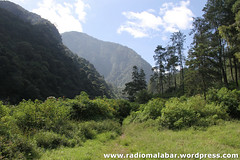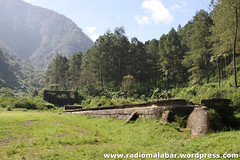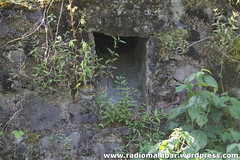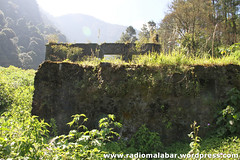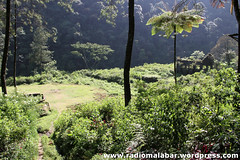Archive
A Monument for J.C. de Groot
I have known this for quite sometime but when I introduced myself to Komunitas Aleut to explain the whole background of what brought me to all this, the leader of the community (Ridwan Hutagalung) reminded me that there was once a memorial monument for Dr. J.C. de Groot in Citarum street in Bandung and that his name was later to be a street name of what is now known as Jalan Siliwangi (Siliwangi Street). Then I was like taking this into my writing agenda for this blog. It has some importance at least for 1) The fact that the monument is now no longer existed, 2) Some people mistakenly refer to the wrong name. The latter I figured out just as I begin to write this blog entry.
Ridwan showed me how the monument looked like. It’s a back cover of a book and it’s not in any way decent to be shown here. Luckily, there’s a website called KITLV in the section of Digital Image Library. One of the pictures is the monument in question :
To its left is one of Bandung’s landmark: Gedung Sate. It is said the the monument was destroyed as it was considered indecent (showing nudity).
The late Bandung historian, Haryoto Kunto, has another picture of this monument from different angle. With some other details, it can be found here. I put it here for the sake of comparison with the above :
The detail there is quite interesting. I should translate it :
—
Di tempat Mesjid Istiqomah sekarang berdiri (Taman Citarum), dahulunya terdapat dua buah monumen peringatan yang sangat fenomenal dimasanya. Pertama Patung dada S.J. Aay, anggota Volksraad yang juga pendiri Ikatan Bintara Militer Belanda (1920) dan Monumen Radio Telefon Holland-Nusantara. Untuk monumen yang kedua, warga Bandung tempo doeloe lebih senang menjuluki monumen itu sebagai “Bloote Billen Plein” alias “Taman Pantat Bugil”. Monumen berbentuk globe dengan dua patung tanpa busana, berhadapan pada masing-masing sisinya. Monumen itu dibuat untuk mengenang pembicaraan pertama kali melalui radio telefon, antara Holland dan Nusantara yang terjadi pada tanggal 5 Mei 1923, melalu instalasi Pemancar Radio Telefon di lereng Gunung Malabar. Untuk memperingati peristiwa bersejarah itu, Walikota Bandung B. Coops, meminta bantuan kepada arsitek Prof. C.P. Wolff Schoemaker, untuk merancang dan mendirikan monumen bersejarah itu. Nasib kedua monumen ini, seperti nasib monumen-monumen lainnya, musnah ditelan jaman.
There were two monuments once considered phenomenal in the place that today is where the mosque of Istiqomah is located (Citarum Garden). The first is the statue of S.J. Aay; the member of Volksraad who were also the founder of Dutch Military Non-Com Union (1920), and the second, the monument of radio telephony between Holland – Indonesia. Bandungers prefered to call the latter “Bloote Billen Plein” or “The Statue of Nude Butt”. It showed a globe with two nude statues in the two side of it. The monument was built to recall the first conversation using radio telephony between the Netherland and Dutch Indies, taken place in 5thMay 1923 using radio telephony transmitter installation in the slope of Malabar Mountain. To commemorate the historical event, the major of Bandung, B. Coops had asked Prof. C.P. Wolff Schoemaker, an architect, to design and build the monument. The monument, like all others, was detroyed.
—
I need to check Haryoto Kunto’s book myself because the mention of that specific date is really startled me! (but I believe the website should be credible enough, though). This is to do with ‘a little debate’ that I have with someone about why the commemoration should take place at 5th May 2013. As you could read from my previous writing, my reason was simply the fact that at that day there was a momentum of the official opening. Now with this account, the date choice is somehow confirmed. If the Dutch consider the date to be historical (so that they need to build a monument for it), why should we think of another ? Okay, it says ‘the first radio telephony conversation’, … it’s somehow denoting the official recognition by the Dutch Government, because we could just imagine that de Groot must have tried the contact before exactly that date. Anyway, it also implies an irony because, as I have written before, at 5thMay 1923, the transmitter failed to work.
Idon’t know what is written in the monument, but a conversation with one of Aleut member has informed me that Haryoto Kunto translated the words into :
Bertepatan dengan peresmian hubungan Radio Telepon antara Indonesia dengan Negeri Belanda tanggal 5 Mei 1923 itu, sebuah upacara telah dilakukan di Tjitaroemplein (Taman Citarum) (Kunto, 1984:262).
My translation :
“In conjunction with the official opening of radio telephony between Indonesia and Netherland at 5thMay 1923, a ceremony was held in Tjitaroemplein (Citarum Garden) (Kunto, 1984: 262).”
I am not sure if it’s really the text. It just doesn’t sound proper.
Anyway, for the second, it refers to the naming of the street: one that is now called Siliwangi street. There are some internet websites saying that the name was once Dr. de Greerweg. I guess it could be more than just two, but at least what I found is here and here. The wording is almost the same, it could be a copy-paste from either one. There’s even a Youtube video mentioning Greerweg :
Now I can tell for sure, that it should be Dr. de Grootweg :)
From The Original to Renewed Plan for the 90th Commemoration
I feel like I have to reveal what I had in mind for the original plan of the commemoration. However, I had to revise it some way for the reason of practicality. For that, I ‘might’ put the original one out from the whole scheme now. I said ‘might’ because I am still opened for any possibility that it could be realized. Later on, I had to widen the revised idea because the new development related to financing.
So the focus is on Radio Malabar. Something is supposed to take place at 05th May 2013. I know the choice for the date could be arguable. RM had been in the process of development in 1917, but not until 1923 it was widely known to public. As of that 05th May, it was when Governor General Dirk Fork officially open this facility. That’s it. I took the momentum of the official opening as the starting date for initial RM state of being.
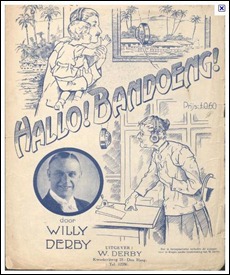 It took sometime afterwards that public communication service was opened in RM. I should look for more detail on this, but that was the moment when the phrase “Hallo Bandung” started to gain special meaning for Dutch people. They were far away from home and it had been so long for them. RM was the one and only mean of communication that they could hear the real voice of their significant others some 20.000 Km away in other continent. So “Hallo Bandung” had an emotional meaning.
It took sometime afterwards that public communication service was opened in RM. I should look for more detail on this, but that was the moment when the phrase “Hallo Bandung” started to gain special meaning for Dutch people. They were far away from home and it had been so long for them. RM was the one and only mean of communication that they could hear the real voice of their significant others some 20.000 Km away in other continent. So “Hallo Bandung” had an emotional meaning.
I don’t know if any Dutch people who could now still feel that way with the phrase, or at least know that the words once existed and of some meanings. At least, one real evidence for this was a song sung by Willy Derby, entitled “Hallo Bandoeng” :
Hallo! Bandoeng!
‘t Oude moedertje zat bevend
Op het telegraafkantoor
Vriend’lijk sprak de ambt’naar
Juffrouw, aanstonds geeft Bandoeng gehoor
Trillend op haar stramme benen
Greep zij naar de microfoon
En toen hoorde zij, o wonder
Zacht de stem van hare zoon
Hallo! Bandoeng!
Ja moeder hier ben ik!
Dag liefste jongen,zegt zij met een snik
Hallo, hallo!
Hoe gaat het oude vrouw?
Dan zegt ze alleen:
Ik verlang zo erg naar jou!
Jongenlief, vraagt ze,hoe gaat het Met je kleine bruine vrouw?
Best hoor, zegt hij,en we spreken
Elke dag hier over jou
En m’n kleuters zeggen ’s avonds
Voor het slapen gaan een gebedHow
Voor hun onbekende opoe
Met een kus op jouw portret
Wacht eens, moeder, zegt hij lachend
‘k Bracht mijn jongste zoontje mee
Even later hoort ze duidelijk
Opoe lief, tabeh, tabeh!
Maar dan wordt het haar te machtig
Zachtjes fluistert ze:
O Heer Dank dat ‘k dat heb mogen horen…
En dan valt ze wenend neer
Hallo! Bandoeng!
Ja moeder hier ben ik!
Ze antwoordt niet.
Hij hoort alleen ‘n snik
Hallo! Hallo!…klinkt over verre zee
Zij is niet meer en het kindje roept: Tabeh
Note: an audio version only can be found here.
A youtube video of the song is here.
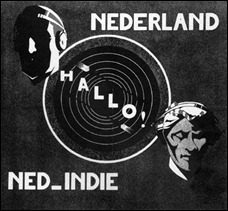 My idea was: how if we simulate a radio transmission right from the ruin of Radio Malabar, in the same band / frequency, to Radio Kootwijk in Netherland at 05th May 2013 ? As I have written before, it was a bad day for de Groot because the transmitter (or transceiver ??) didn’t work. Now, how if we transmit the voice of “Hallo Kootwijk” and “ Hallo Bandoeng” at that day and try not to fail ? This is not a mockery. For me this is more like, if we could travel back through time, we would tell de Groot that the future thanks for what he did and that here we have reached this stage of evolution that communication to all over the world is not a problem anymore. He was an important part of the World’s Radio History that human being should note. We are now in a much better time with the technology and that 90 years has really made a huge difference!
My idea was: how if we simulate a radio transmission right from the ruin of Radio Malabar, in the same band / frequency, to Radio Kootwijk in Netherland at 05th May 2013 ? As I have written before, it was a bad day for de Groot because the transmitter (or transceiver ??) didn’t work. Now, how if we transmit the voice of “Hallo Kootwijk” and “ Hallo Bandoeng” at that day and try not to fail ? This is not a mockery. For me this is more like, if we could travel back through time, we would tell de Groot that the future thanks for what he did and that here we have reached this stage of evolution that communication to all over the world is not a problem anymore. He was an important part of the World’s Radio History that human being should note. We are now in a much better time with the technology and that 90 years has really made a huge difference!
However, in the end, it sounds like too much of a romantic idea :) My discussion with some amateur radio members and others in emails have opened up my eyes that it is just too good to be true :
-
The band of communication de Groot used at that time is called Low Frequency. It is the band of communication that is covered in the radio bandplan in Netherland, but not here in Indonesia. One told me that for special purpose, we could propose for usage to the government, but everybody knows it is not going to be as easy as snapping fingers.
-
Even if we are licensed to use the band, communication is not going to be easy. As the band is out of the plan, it goes without saying that it would only hard to find anybody who owns a communication radio capable of transmitting in the band! OK, we could turn to the community of radio amateur who have this ‘creed’ to building a radio from scratch (called homebrewing). I also have contacted some people in that community. Their response leads to number 3 :
-
Even with today’s technology, we would need a huge electric power to generate oscilator in that specific band and it is just not practical. An amateur radio facebook friend, Mr. Daryono, promised me that he’ll do his best to find information whether communication in Low Frequency could be carried out in low power (something called QRP). He took it as a challenge, at least in terms of knowledge.
-
The antenna. Anything huge in size back then might be thought of something to do with technological achievement in that day. However, it’s not true entirely. De Groot had a reason that he had to build ‘berg antenna’ ranging from the top of the mountain down to the slope to the Radio Malabar building with 2 Km of cables. It was supposed to be like that! Now would it be efficient to try to communicate to Netherland involving all this essential demanding part ?
-
Propagation. Communicating in Low Frequency is not something we could do anytime in a day, even a year. I don’t know much about this, but ionospherical and other factors in the sky would influence the success of radio contact.
So, given all of those obstacles, I personally think that the idea of simulation might not be a good choice, at least for now. Instead, we could just take the essence of the moment, and it’s a “Radio Contact” and that radio contact could be in any band / frequency. To the best of my knowledge, it is in High Frequency (HF): something that might be casual thing to do for some amateur radio members with their DX rigs.
OK, if anything should matter, amateur radio member could still do the DX in a more meaningful way. Say, how if the communication takes place not in the usual QTH station of an amateur, but out there, right from around the ruin of Radio Malabar, and the same way with the other part in the actual place of Radio Kootwijk building (which is said to be still very much intact) ? As with the communication itself, yes it’s going to be the exchange of “Hallo Kootwijk”, “Hallo Bandung”, etc, … but it could be planned in such a way that it conforms to the ‘tradition’ of Amateur Radio: Be it Special Call, International Logging Contest, whatever… I am not sure which are doable, but it can be discussed. (this latter idea of QTH is only my personal thought and subject to change if circumstances don’t fit).
Such is my original plan, but now it has to change. Not in terms of the kind of activity, but rather, in scope. The commemoration is going to be financed by a company (at least one company for now) as part of it’s CSR program; a company that has a historical root with Radio Malabar. The main point for this is that the commemoration should not only gain international public awareness in a day, but also to facilitate long-term public learning about history. For that, one clear choice is to refine Radio Malabar as a tourist object. It’s a ‘refine’ because it’s already part of Gunung Puntang Area as a tourism destination, only that nothing specific is given to it until now that would highlight Radio Malabar as a central point of interest. As with the area of Gunung Puntang itself, it is a fact that almost all supporting infrastructure in the area have been degraded and in need for some serious repair, improvement, and maybe even rebuilding.
For that bigger scope, I know that there was the so-called ‘Festival Gunung Puntang 2009’. I have made contact, seen them, engaged in some discussions, even gone to Gunung Puntang together with them yesterday. I will share the story for the next entry of this blog.
In Context with The History of Wireless Tech
The books I refer in the previos entry were these :
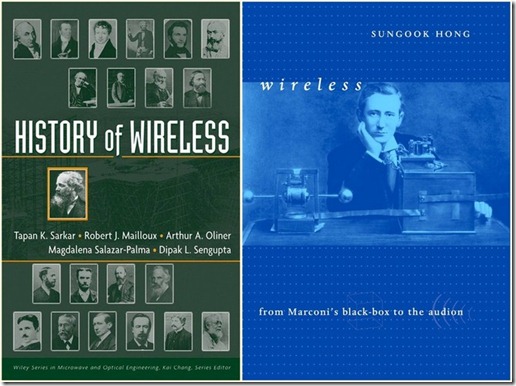
Both of which don’t mention anything about Radio Malabar. Have I been assuming too much ? Could it be that Radio Malabar was only one of radio stations in the world using Arc Poulsen (and later Telefunken’s) Transmitter ? Was it really the biggest transmitter in the world ? Those are among the questions that someday I hope I could find the answer.
However, historically speaking, the books are important in term of that they could give a context of where we should place Radio Malabar in the development history of wireless communication. Hong’s is somewhat limited to the early years of twentieth century, while Sarkar’s et al. includes a chapter entitled “A Chronology of Development of Wireless Communication and Supporting Electronics”. Part of the chapter is “Some Crucial Events of Twentieth Century”; that’s about the time when Dr. C.J. de Groot went to Karlsruhe in 1906 to study “Electrical Engineering” until he built Radio Malabar in 1922 – 1923.
I am lucky to be able to get the part of the book from Google Books. I have saved the relevant part (from 1906 to 1923) here. This is not at all assuming that de Groot should have known all the development at that time. I suppose technical innovation from different parts of the world back then was not easily disseminated world-wide. Once again, it is for the purpose of putting Radio Malabar in context with the history of wireless (communication) technology.




